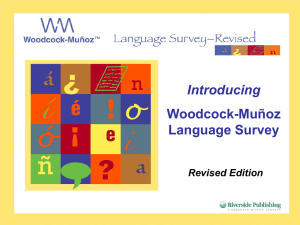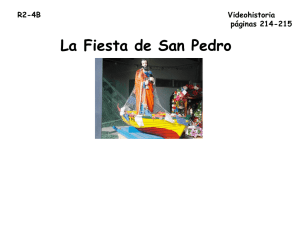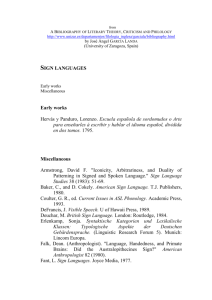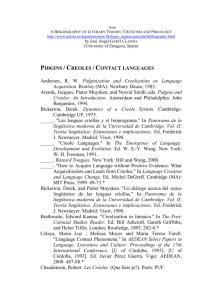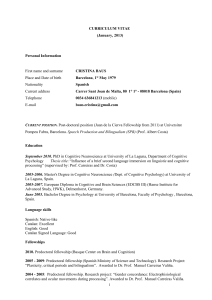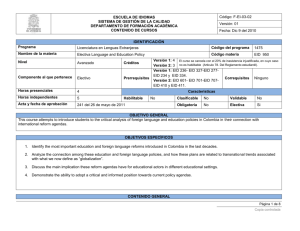Español 521 - Longwood University
advertisement
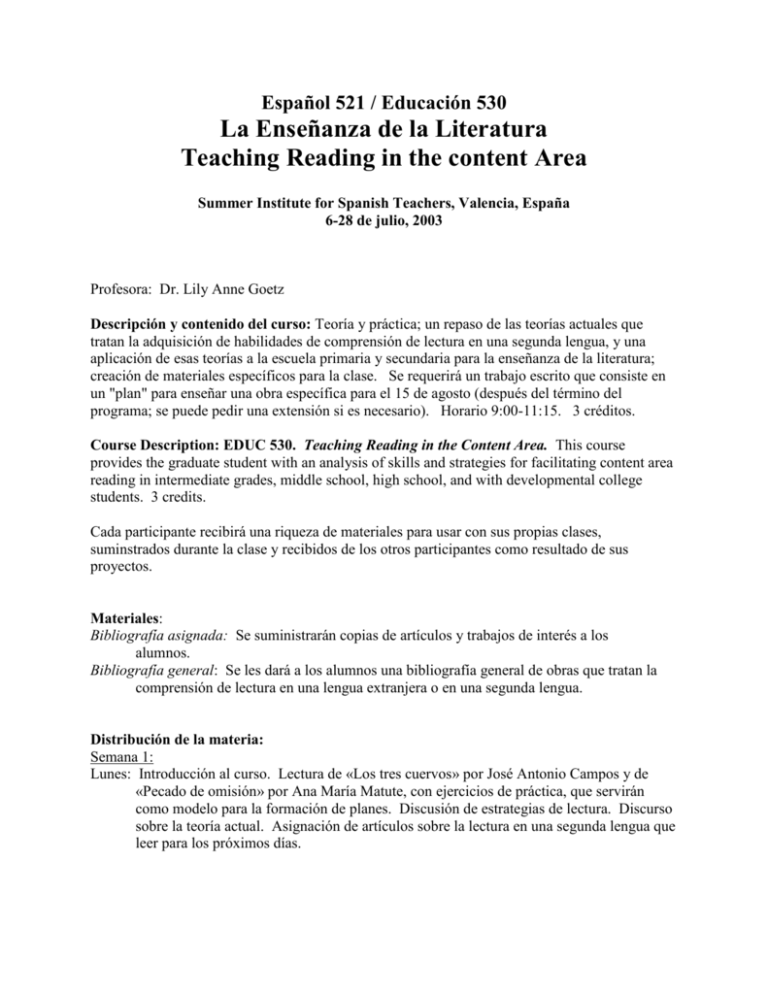
Español 521 / Educación 530 La Enseñanza de la Literatura Teaching Reading in the content Area Summer Institute for Spanish Teachers, Valencia, España 6-28 de julio, 2003 Profesora: Dr. Lily Anne Goetz Descripción y contenido del curso: Teoría y práctica; un repaso de las teorías actuales que tratan la adquisición de habilidades de comprensión de lectura en una segunda lengua, y una aplicación de esas teorías a la escuela primaria y secundaria para la enseñanza de la literatura; creación de materiales específicos para la clase. Se requerirá un trabajo escrito que consiste en un "plan" para enseñar una obra específica para el 15 de agosto (después del término del programa; se puede pedir una extensión si es necesario). Horario 9:00-11:15. 3 créditos. Course Description: EDUC 530. Teaching Reading in the Content Area. This course provides the graduate student with an analysis of skills and strategies for facilitating content area reading in intermediate grades, middle school, high school, and with developmental college students. 3 credits. Cada participante recibirá una riqueza de materiales para usar con sus propias clases, suminstrados durante la clase y recibidos de los otros participantes como resultado de sus proyectos. Materiales: Bibliografía asignada: Se suministrarán copias de artículos y trabajos de interés a los alumnos. Bibliografía general: Se les dará a los alumnos una bibliografía general de obras que tratan la comprensión de lectura en una lengua extranjera o en una segunda lengua. Distribución de la materia: Semana 1: Lunes: Introducción al curso. Lectura de «Los tres cuervos» por José Antonio Campos y de «Pecado de omisión» por Ana María Matute, con ejercicios de práctica, que servirán como modelo para la formación de planes. Discusión de estrategias de lectura. Discurso sobre la teoría actual. Asignación de artículos sobre la lectura en una segunda lengua que leer para los próximos días. Martes: Discusión de artículos (Phillips, Young, Goetz) y de teoría. Modelos para hojas de práctica para los alumnos. La enseñanza de la narrativa; Monterroso, «El dinosaurio». Miércoles: Artículos (Barnett, Lee, Lee). La narrativa. Denevi, «Génesis» y «Apocalipsis». Ejercicio: Millás, «Carta del enamorado». Jueves: Artículos (Bernhardt, Harper). La narrativa. Madrid: «La mirada». Laforet: «Rosamunda». Introducción a Cortázar, «La noche boca arriba». Viernes: Discusión de artículos (Henning, Nance). Discusión de estrategias. Cortázar, «La noche boca arriba». Asignación de proyectos y presentaciones. Semana 2: Lunes: Discusión del capítulo 4 por Barnett. Cortázar, «La noche boca arriba». La ensenañza de la novela. Martes: Discusión de artículos (Knutson, Henderson). La enseñanza de la poesía. Demostración de un plan para el poema «Hombres necios» por Sor Juana Inés de la Cruz. Miércoles: Discusión de artículos (Arens y Swaffar). «Hombres necios» por Sor Juana Inés de la Cruz. Figuras retóricas. Jueves: Discusión de artículos (Gilroy/Parkinson, Tucker). Poesía; figuras retóricas. «Guías» para la lectura. Diseño de una lección para enseñar «Volverán las oscuras golondrinas» y «Yo sé un himno gigante» por Bécquer. Viernes: Presentaciones y discusión de artículos asignados. Poesía. «Recuerdo Infantil» y «Caminante» por Machado. Góngora, «Soneto CLXV Mientras por competir con tu cabello». Sor Juana Inés de la Cruz, «A su retrato». Semana 3: Lunes: Presentaciones y discusión de artículos asignados. Taller: preparación en grupos de un plan para un cuento o un poema. Martes: Presentaciones y discusión de artículos asignados. Taller: preparación continuada en grupos de un plan para un cuento o un poema. Discusión de proyectos individuales. Miércoles: Presentaciones y discusión de artículos asignados. Preparación continuada en grupos, y presentaciones del plan de cada grupo. Discusión de proyectos individuales. Jueves: Presentaciones y discusión de artículos asignados. Taller: Proyectos individuales. Viernes: Presentaciones y discusión de proyectos. Examen final. Requisitos del curso: 10% Participación en las discusiones. 20% Presentación de dos artículos y resúmenes escritos 20% Proyectos—Presentaciones orales 30% Proyecto—Plan escrito 20% Examen final. Calificaciones 94-100 A Sobresaliente 85-93 B Notable 71-84 C Aprobado 70 F Insuficiente Cada alumno presentará una discusión y un resumen escrito basados en dos de los textos asignados (20%), y preparará dos "lecciones" sobre textos literarios específicos—una con la ayuda de otros en la clase y otra individual, con materiales que los otros participantes puedan utilizar con sus propias clases (2 Presentaciones orales—20%; Plan individual escrito—30%). Con el permiso de cada participante, se repartirán los planes escritos a todos los participantes de la clase después del curso. Trabajo final de investigación: Cada participante escribirá un trabajo de investigación según las instrucciones suministradas para el 30 de septiembre (después del término del programa). El trabajo se formará de acuerdo con las teorías e ideas que se han discutido durante el curso y consistirá en un plan para enseñar una obra literaria, de 8 páginas, por lo menos, a doble espacio, excepto cualquier hoja de práctica diseñada para el uso del alumno, que debe ser visualmente atractiva y clara. La bibliografía de obras citadas o consultadas debe estar de acuerdo con las normas del MLA. El trabajo se enviará a la Profesora Goetz antes del 30 de septiembre del 2003. (Se puede pedir una extensión si es necesario). Asistencia: La asistencia a todas las clases es mandatoria. La inasistencia a una sesión o a dos horas de clase reducirá la calificación final en un diez por ciento (10%). La inasistencia a dos sesiones o a cuatro horas de clase implicará la pérdida del curso. Bibliography: Required Readings (included in reading packet for EDUC 530 / SPAN 521): Arens, Katherine and Janet Swaffar. "Reading Goals and the Standards for Foreign Language Learning." Foreign Language Annals 33.1 (Jan./Feb. 2000): 104-22. Barnett, Marva A. “More than meets the Eye: Foreign Language Reading.” Language and Education: Theory and Practice. Englewood Cliffs, NJ: Prentice Hall, 1989. ---. "Teaching Reading Strategies: How Methodology Affects Language Course Articulation." Foreign Language Annals 21.2 (1988): 109-19. Bernhardt, Elizabeth B. "Teaching Literature or Teaching Students?" ADFL Bulletin 26.2 (1995): 5-6. Carrell, Patricia L. "Metacognitive Awareness and Second Language Reading." The Modern Language Journal 73.2 (1989): 121-34. ---. "Schema Theory and ESL Reading: Classroom Implications and Applications." Modern Language Journal 68 (1984): 332-43. Friedman, Edward H. "Effective Stylistics; or, The Pressure of the Text: Foreign Literature and the Undergraduate." ADFL Bulletin 23.3 (1992): 18-22. Gilroy, Marie and Brian Parkinson. “Teaching Literature in a Foreign Language.” Language Teaching 29.4 (1996): 213-25. Goetz, Lily Anne. “Short Cuts: A Model for Using the Shortest of Short Stories to Teach Second Language Reading Skills.” Forthcoming in NECTFL Review (Fall 2003). Graden, Ellen Collie. “How Language Teachers’ Beliefs About Reading Instruction Are Mediated by Their Beliefs About Students.” Foreign Language Annals 29.3 (Fall 1996): 387-95. Harper, Sandra N. “Strategies for Teaching Literature at the Undergraduate Level.” The Modern Language Journal 72 (1988): 402-08. Hauptman, Philip C. “Some Hypotheses on the Nature of Difficulty and Ease in Second Language Reading: An Application of Schema Theory.” Foreign Language Annals 33.6 (2000): 622-31. Henning, Sylvie Debevec. “Assessing Literary Interpretation Skills.” Foreign Language Annals 25 (1992): 33955. Hulstijn, Jan H. "When do Foreign-Language Readers Look Up the Meaning of Unfamiliar Words? The Influence of Task and Learner Variables." Modern Language Journal 77 (1993): 140-47. Knutson, Elizabeth K. "Reading with a Purpose: Communicative Reading Tasks for the Foreign Language Classroom." Northeast Conference Newsletter 44 (Fall 1998): 39-44. Lee, James F. "The Effects of Three Components of Background Knowledge on Second Language Reading." Modern Language Journal 70 (1986): 350-54. ---. "Toward a Modification of the 'Proficiency' Construct for Reading in a Foreign Language." Hispania 71.4 (1988): 941-53. ---. "Various Aspects of Current Theories of Foreign Language Teaching." Hispania 69.1 (1986): 181-87. Nance, Kimberly A. “Developing Students’ Sense of Literature in the Introductory Foreign Language Literature Course.” ADFL Bulletin 25.2 (Winter 1994): 23-29. Phillips, June K. "Practical Implications of Recent Research in Reading." Foreign Language Annals 17.4 (1984): 285-96. Swaffar, Janet K. "Readers, Texts, and Second Languages: The Interactive Processes." Modern Language Journal 72.2 (1988): 123-49. Tesser, Carmen Chaves and Donna Reseigh Long. “The Teaching of Spanish Literature: A Necessary Partnership between the Language and Literature Sections of Traditional Departments.” Foreign Language Annals 33.6 (2000): 605-13. Tucker, Holly. "The Place of the Personal: The Changing Face of Foreign Language Literature in a StandardsBased Curriculum." ADFL Bulletin 31 (2000): 54-58. Young, Dolly Jesusita. “Linguistic Simplification of SL Reading Material: Effective Instructional Practice?” The Modern Language Journal 83.3 (1999): 350-66. ---. "A Systematic Approach to Foreign Language Reading Instruction: What Does the Research Suggest?" Hispania 72 (1989): 755-62. ---. "Processing Strategies of Foreign Language Readers: Authentic and Edited Input." Foreign Language Annals 26.4 (1993): 451-68. Bibliography Reading in a Second Language Readings of interest in addition to the above Adair-Hauck, Bonnie. "Practical Whole Language Strategies for Secondary and University-level Foreign Language Students." Foreign Language Annals 29.2 (1996): 253-70. Aebersold, Jo Ann and Mary Lee Field. From Reader to Reading Teacher: Issues and Strategies for Second Language Classrooms. Cambridge: Cambridge University Press, 1997. Allen, Edward David and Rebecca M. Valette. Classroom Techniques: Foreign Languages and English as a Second Language. Prospect Heights, IL: Waveland Press, 1994. Anderson, Neil J. "Individual Differences in Strategy Use in Second Language Reading and Testing." Modern Language Journal 75.4 (1991): 460-72. Arden-Close, Christopher. "NNS Readers' Strategies for Inferring the Meanings of Unknown Words." Reading in a Foreign Language 9.2 (1993): 867-93. Arens, Katherine and Janet Swaffar. "Reading Goals and the Standards for Foreign Language Learning." Foreign Language Annals 33.1 (Jan./Feb. 2000): 104-22. ---. Reading for Meaning: An Integrated Approach to Language Learning. Englewood, NJ: Prentice Hall, 1991. Ariel, Tzivia. "Teaching Reading Skills in a Foreign Language." English Teachers' Journal: Israel 46 (1993): 6365. Bamford, Julian, and Richard R. Day. "Teaching Reading." Annual Review of Applied Linguistics 18 (1998): 12441. Barkon, Elisheva. "The Role of Proficiency in Foreign Language Reading Comprehension." English Teachers' Journal: Israel 46 (1993): 59-62. Barnett, Marva A. "How Receptive to New Ideas Are We? Reading and Listening Proficiency." ADFL Bulletin 20 (1988): 29-32. ---. More than Meets the Eye. Foreign Language Reading: Theory and Practice. Englewood Cliffs, NJ: Prentice Hall, 1989. ---. "Reading through Context: How Real and Perceived Strategy Use Affects L2 Comprehension." Modern Language Journal 72.2 (1988): 150-62. ---. "Syntactic and Lexical/Semantic Skill in Foreign Language Reading: Importance and Interaction." Modern Language Journal 70 (1986): 343-49. ---. "Teaching Reading Strategies: How Methodology Affects Language Course Articulation." Foreign Language Annals 21.2 (1988): 109-19. Barnitz, John G. and Richard B. Speaker, Jr. "Second Language Readers' Comprehension of a Poem: Exploring Contextual and Linguistic Aspects." World Englishes 10.2 (1991): 197-209. ---. "Toward Understanding the Effects of Cross-Cultural Schemata and Discourse Structure on Second Language Reading Comprehension." Journal of Reading Behavior 18.2 (1986): 95-116. Bell, Fleming L. and Leona B. LeBlanc. “The Language of Glosses in L2 Reading on Computer: Learners’ Preferences.” Hispania 83 (May 2000): 274-85. Bernhardt, Elizabeth B. "Interpreting Relationships between L1 and L2 Reading: Consolidating the Linguistic Threshold and the Linguistic Interdependence Hypotheses." Applied Linguistics 16.1 (1995): 15-34. ---. Reading Development in a Second Language: Theoretical, Empirical, and Classroom Perspectives. Norwood, NJ: Ablex, 1991. ---. "Reading in the Foreign Language." 93-115 in Barbara Wing, ed., Northeast Conference Reports: Listening, Reading, and Writing: Analysis and Application. Middlebury, VT: Northeast Conference on the Teaching of Foreign Languages. 1986. ---. "Teaching Literature or Teaching Students?" ADFL Bulletin 26.2 (1995): 5-6. ---. "Toward an Information Processing Perspective in Foreign Language Reading." Modern Language Journal 68 (1984): 322-31. Brantmeier, Cindy. "Second Language Reading Research on Passage Content and Gender: Challenges for the Intermediate-Level Curriculum." Foreign Language Annals 34 (2001): 325-33. Brown, Carol M. “L2 Reading: An Update on Relevant L1 Research.” Foreign Language Annals 31.2 (Summer 1998): 191-202. Carrell, Patricia L. "Content and Formal Schemata in ESL Reading." TESOL Quarterly 21 (1987): 461-81. ---. "Metacognitive Awareness and Second Language Reading." The Modern Language Journal 73.2 (1989): 12134. ---. "Schema Theory and ESL Reading: Classroom Implications and Applications." Modern Language Journal 68 (1984): 332-43. Carrell, P. L, J. Devine and D. E. Eskey, eds. Interactive Approaches to Second Language Reading. Cambridge: Cambridge University Press, 1988. Corneau, L., P. Cormier, E. Grandmaison and D. Lacroix. “A Longitudinal Study of Phonological Processing Skills in Children Learning to Read in a Second Language.” Journal of Educational Psychology 91.1 (1999): 2943. Davis, James N. "How Do L1 and L2 Reading Differ? Evidence from Think Aloud Protocols." Modern Language Journal 77.4 (1993): 459-72. Davis, James N., Lynn Carbón Gorell, Rebecca R. Kline and Gloria Hsieh. "Readers and Foreign Languages: A Survey of Undergraduate Attitudes toward the Study of Literature." Modern Language Journal 76.3 (1992): 320-32. Day, Richard R. and Julian Bamford. Extensive Reading in the Second Language Classroom. Cambridge: Cambridge University Press, 1998. Devitt, Seán. "Interacting with Authentic Texts: Multilayered Processes." Modern Language Journal 81 (1997): 457-69. DiPietro, Robert J. Strategic Interaction. Learning Languages through Scenarios. Cambridge: Cambridge University Press, 1987. Fecteau, Monique L. “First- and Second-Language Reading Comprehension of Literary Texts.” Modern Language Journal 83.4 (1999): 475-93. Fischer, Ute. "Learning Words from Context and Dictionaries: An experimental Comparison." Applied Psycholinguistics 15.4 (1994): 551-74. Fitzgerald, J. “English-as-a-Second-Language Reading Instruction in the United States: A Research Review.” Journal of Reading Behavior 27.2 (1995): 115-52. Friedman, Edward H. "Effective Stylistics; or, The Pressure of the Text: Foreign Literature and the Undergraduate." ADFL Bulletin 23.3 (1992): 18-22. Gettys, Serafina, Lorens A. Imhof, and Joseph O. Kautz. "Computer-Assisted Reading: The Effect of Glossing Format on Comprehension and Vocabulary Retention." Foreign Language Annals 34 (2001): 91-106. Gilroy, Marie and Brian Parkinson. “Teaching Literature in a Foreign Language.” Language Teaching 29.4 (1996): 213-25. Goetz, Lily Anne. “Short Cuts: A Model for Using the Shortest of Short Stories to Teach Second Language Reading Skills.” Forthcoming in NECTFL Review (Fall 2003). Goodman, Kenneth S. "Reading: A Psycholinguistic Guessing Game." Journal of the Reading Specialist 6 (1967): 126-35. Grace, Caroline A. “Retention of Word Meanings Inferred from Context and Sentence-Level Translations: Implications for the Design of Beginning-Level CALL Software.” Modern Language Journal 82.4 (1998):533-44. Graden, Ellen Collie. “How Language Teachers’ Beliefs About Reading Instruction Are Mediated by Their Beliefs About Students.” Foreign Language Annals 29.3 (Fall 1996): 387-95. Hanley, J. E. B., C. A. Herron and S. P. Cole. “Using Video as an Advance Organizer to a Written Passage in the FLES Classroom.” The Modern Language Journal 79 (1995): 57-66. Harper, Sandra N. “Strategies for Teaching Literature at the Undergraduate Level.” The Modern Language Journal 72 (1988): 402-08. Hauptman, Philip C. “Some Hypotheses on the Nature of Difficulty and Ease in Second Language Reading: An Application of Schema Theory.” Foreign Language Annals 33.6 (2000): 622-31. Hays, Nancy and Leslie Schrier. "Encouraging Second Language Literacy in the Early Grades." Hispania 83 (2000): 86- . Henning, Sylvie Debevec. “Assessing Literary Interpretation Skills.” Foreign Language Annals 25 (1992): 33955. Hernández, José Salvador. "Assisted Performance in Reading Comprehension Strategies with Non-English Proficient Students." Journal of Educational Issues of Language Minority Students 8 (1991): 91-112. Hiebert, E. H. “Becoming Literate Through Authentic Tasks: Evidence and Adaptations.” 391-413 in Ruddell, R.S., M.R. Ruddell and H. Singer, eds., Theoretical Models and Processes of Reading. Newark, DE: International Reading Association, 1994. Hosenfeld, Carol, Vicki Arnold, Jeanne Kirchofer, Judith Laciura, and Lucia Wilson. "Second Language Reading: A Curricular Sequence for Teaching Reading Strategies." Foreign Language Annals 14 (1981): 415-22. Hudson, Thom. "The Effects of Induced Schemata on the 'Short Circuit' in L2 Reading: Non- Decoding Factors in L2 Reading Performance." Language Learning 32 (1982): 1-31. --. "Theoretical Perspectives on Reading." Annual Review of Applied Linguistics 18 (1998): 43-60. Hulstijn, Jan H. "When do Foreign-Language Readers Look Up the Meaning of Unfamiliar Words? The Influence of Task and Learner Variables." Modern Language Journal 77 (1993): 140-47. Jacobs, George M. “What Lurks in the Margin: Use of Vocabulary Glosses as a Strategy in Second Language Reading.” Issues in Applied Linguistics 5.1 (1994): 115-37. Johnson, Patricia. "Effects on Comprehension of Building Background Knowledge." TESOL Quarterly 16 (1982): 503-16. Kang, Hee-Won and Anne Golden. "Vocabulary Learning and Instruction in a Second or Foreign Language." International Journal of Applied Linguistics 4 (1994): 57-77. Kern, Richard. Literacy and Language Teaching. Oxford: Oxford University Press, 2000. Klapper, John. "Practicable Skills and Practical Constraints in FL Reading." Language Learning Journal 7 (1993): 50-54. Klein, Eberhard. "Elemenets of Text Type-Oriented Model of Second Language Reading within a Communicative EFL/ESL Syllabus." Reading 25.3 (1991): 29-33. Kintsch, W. and T. van Dijk. "Toward a Model of Text Comprehension and Production." Psychological Review 85 (1978): 363-94. Koda, Keiko. "The Effects of Lower-Level Processing Skills on FL Reading Performance: Implications for Instruction." Modern Language Journal 76 (1992): 502-12. ---. “Second Language Reading Research: Problems and Possibilities.” Applied Psycholinguistics 15.1 (1994): 128. Kost, Claudia R., Pamelo Foss and John J. Lenzini, Jr. “Textual and Pictorial Glosses: Effectiveness on Incidental Vocabulary Growth When Reading in a Foreign Language.” Foreign Language Annals 32.1 (1999): 89113. Knutson, Elizabeth K. "Reading with a Purpose: Communicative Reading Tasks for the Foreign Language Classroom." Northeast Conference Newsletter 44 (Fall 1998): 39-44. Kramsch, Claire. Context and Culture in Language Teaching. Oxford: Oxford University Press, 1993. Lee, James F. "The Effects of Three Components of Background Knowledge on Second Language Reading." Modern Language Journal 70 (1986): 350-54. ---. "Toward a Modification of the 'Proficiency' Construct for Reading in a Foreign Language." Hispania 71.4 (1988): 941-53. ---. "Various Aspects of Current Theories of Foreign Language Teaching." Hispania 69.1 (1986): 181-87. Lee, J. and D. L. Schallert. “The Relative Contribution of L2 Language Proficiency and L1 Reading Ability to L2 Reading Performance.” TESOL Quarterly 31.4 (1997): 713-39. Leow, Ronald P. "Do Learners Notice Enhanced Forms While Interacting with the L2?: An Online and Offline Study of the Role of Written Input Enhancement in L2 Reading." Hispania 84 (20012): 496-509. Liaw, Meei-Ling. "Exploring Literary Responses in an EFL Classroom." Foreign Language Annals 34 (2001): 3545. Mackay, Ronald, Bruce Barkman and R. R. Jordan. Reading in a Second Language: Hypotheses, Organization, and Practice. Rowley, Massachusetts: Newbury House, 1979. McKay, S. Agendas for Second Language Literacy. Cambridge, England: Cambridge University Press, 1993. Mecartty, Frances H. “The Effects of Proficiency Level and Passage Content on Reading Skills Assessment.” Foreign Language Annals 31.4 (Winter 1998): 517-34. Nance, Kimberly A. “Developing Students’ Sense of Literature in the Introductory Foreign Language Literature Course.” ADFL Bulletin 25.2 (Winter 1994): 23-29. Nutall, Christine. Teaching reading skills in a foreign language. Chicago: Heinemann English Language Teaching, 1996. Phillips, June K. "Practical Implications of Recent Research in Reading." Foreign Language Annals 17.4 (1984): 285-96. Riley, Gail L. "A Story Structure Approach to Narrative Text Comprehension." Modern Language Journal 77.4 (1993): 418-32. Roller, C. M. “The Interaction between Knowledge and Structure Variables in the Processing of Expository Prose.” Reading Research Quarterly 25 (1990): 79-89. Roller, Cathy M. and Alex R. Matambo. "Bilingual Readers' Use of Background Knowledge in Learning from Text." TESOL Quarterly 26.1 (1992): 129-41. Rusciolelli, Judith. “Student Responses to Reading Strategies Instruction.” Foreign Language Annals 28.2 (1995): 262-73. Ruiz-Funes, Marcela. “Writing, Reading, and Reading-to-Write in a Foreign Language: A Critical Review.” Foreign Language Annals 32.4 (1999): 514-26. ---. "Writing, Reading, and Reading-to-Write in a Foreign Language: A Critical Review." Foreign Language Annals 32.4 (1999): 514-26. Rumelhart, David E. "Toward an Interactive Model of Reading." 573-603 in Stanislaus Dornic, ed., Attention and Performance VI. Hillsdale, NJ: Lawrence Erlbaum Associates. Rusciolelli, Judith. "Student Responses to Reading Strategies Instruction." Foreign Language Annals 28.2 (1995): 262-73. Sellers, Vanisa D. “Anxiety and Reading Comprehension in Spanish as a Foreign Language.” Foreign Language Annals 33.5 (2000): 512-21. Shook, D. J. “Foreign Language Literature and the Beginning Learner-Reader.” Foreign Language Annals 29 (1996): 201-16. Smith, Frank. Psycholinguistics and Reading. New York: Holt, Rinehart, and Winston, 1973. Swaffar, Janet K. "Readers, Texts, and Second Languages: The Interactive Processes." Modern Language Journal 72.2 (1988): 123-49. ---. "Reading Authentic Texts in Foreign Language: A Cognitive Model." Modern Language Journal 69 (1985): 15-34. Swaffar, Janet K., Katherine M. Arens, and Heidi Byrnes. Reading for Meaning: An Integrated Approach to Language Learning. Englewood Cliffs, NJ: Prentice-Hall, 1991. Tesser, Carmen Chaves and Donna Reseigh Long. “The Teaching of Spanish Literature: A Necessary Partnership between the Language and Literature Sections of Traditional Departments.” Foreign Language Annals 33.6 (2000): 605-13. Tucker, Holly. "The Place of the Personal: The Changing Face of Foreign Language Literature in a StandardsBased Curriculum." ADFL Bulletin 31 (2000): 54-58. Wolf, Darlene F. "A Comparison of Assessment Tasks Used to Measure FL Reading Comprehension." Modern Language Journal 77.4 (1993): 473-89. Young, Dolly Jesusita. “Linguistic Simplification of SL Reading Material: Effective Instructional Practice?” The Modern Language Journal 83.3 (1999): 350-66. ---. "A Systematic Approach to Foreign Language Reading Instruction: What Does the Research Suggest?" Hispania 72 (1989): 755-62. ---. "Processing Strategies of Foreign Language Readers: Authentic and Edited Input." Foreign Language Annals 26.4 (1993): 451-68.
